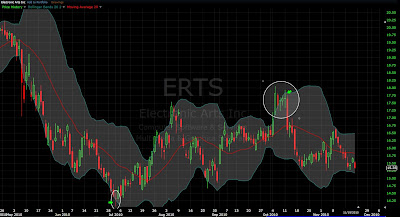Saturday, November 20, 2010
A Note about Doji Candlesticks
I'm going to give a little presentation on doji candlesticks. A candlestick chart is a type of bar price chart that shows the open, close, high, and low for the over a specific period of time. The two charts I have below are a daily candlestick charts and a weekly candlestick chart, but you can use them for any time period you like. Candlestick charts were developed in Japan in the 1700's to chart and predict the movement of rice prices. Though the candlestick chart is extremely old, the analysis you use for them has remained much the same over the centuries. Today's stock traders are looking for the same patterns that people did before computers were involved. The reason that the analysis has remained mostly the same is because the psychology of markets has remained the same. Candlesticks give a person a window into the psychology of a stock over a specific period of time. The Japanese found that certain types of market psychologies lead to higher chances of specific outcomes and have honed the technique to make predictions.
Since there are far too many candlestick shapes and patterns to discuss in a short article, I will focus on what most traders would consider the most important. The doji can be considered to be the most important candlestick pattern because it works fairly well and it is extremely easy to spot. More traders pay attention to it because it is easy to see on a chart. This gives it the benefit of the potential of a self fulfilling prophecy. A doji represents an equilibrium in a stock. That means that the open and the close were the same or nearly the same. There are 4 different types of doji, but I don't want to get too into the woods in this article. I recommend the book Japanese Candlestick Charting Techniques, Second Edition written by Steve Nison if you want exhaustive coverage of doji and other candlesticks. I'd prefer to give an example and let you see how they can be powerful investing tools.
Here is a daily chart for the stock Electronic Arts (ERTS). This is a stock that some of our clients currently hold. I'd like to first point out the doji that occurs in early July 2010. I have it circled and arrowed on the chart above. This would be considered a long legged doji which means that the highs and lows for the day were fairly far off the open and the close. Doji are actually a fairly common occurrence and I don't want to mislead you into thinking that they are always important. Generally speaking, doji are only significant when they occur at the top or bottom of a trend. Here, there had been an extremely long down trend in ERTS. We then had a doji at the bottom of the Bollinger band. I consider this a strong buy signal in the stock. There was indecision at this point after the stock had taken a massive clobbering.
The second doji I want to focus on is the one that I have circled and arrowed in October. There are actually two doji in the circle. Here there was not really a trend and the doji just represented indecision. The fact that there were multiple doji in a row after a strong up move meant that stock was resting while trying to figure out what to do next. Here it meant bad things were going to happen.
Like I said previously, the nice thing about doji and candlesticks is that they work on any time frames. The chart below is showing the same period as the first chart. Notice how the following two weeks after there was a doji on the daily chart in July, there was also two doji on the weekly chart. This shows the indecision of the stock and can once again be viewed as a good entry point because there is a decent probability of the stock turning around from here. The double doji followed by a bullish engulfing candle in the circle shows that the stock has entered a new more bullish phase. Of course you would not want to make an investment solely based on the appearance of a particular candle pattern. Asif and I had been contemplating entering ERTS for a long time and felt that after viewing these candles play out that it was a good time to enter the stock.
I hope this article offered some kind new insight to your investing strategy. If you have any questions or feel that investing is better left to professionals, please feel free to contact us at panopticmc@gmail.com.
Subscribe to:
Comments (Atom)


